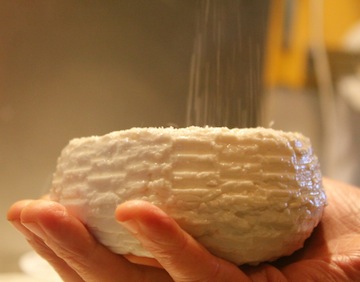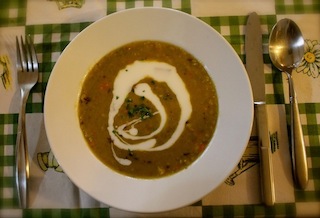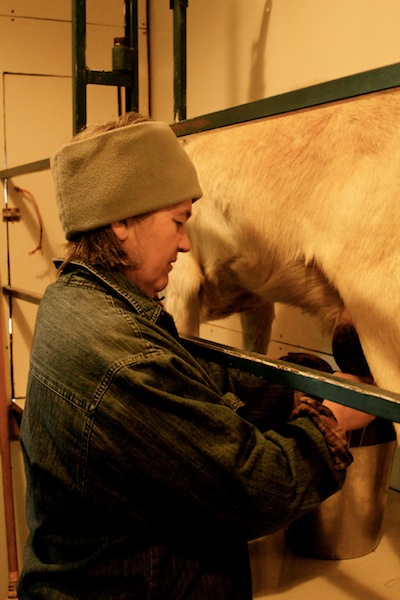My Week at Quillisascut: Why Everyone Should Go to ‘Farm School’
- by Vera Chang
Since I moved to Seattle a year and a half ago, there’s no farm whose name has come up more than Quillisascut, located in the foothills of the Huckleberry Mountains in Rice, WA. And since I visit farms as Bon Appétit Management Company Foundation’s West Coast Fellow, I have lots of conversations about food and farming. Quillisascut is a cheese company, selling what they call “traditional farmstead cheese from the pampered pets of Pleasant Valley,” but it’s also a school for the domestic arts.
After completing a five-day “Introduction to Farming” workshop at Quillisascut recently, nicely documented by Farmgirl Gourmet, I understand why this farm school is so beloved by food service professionals, healthcare students, farmers and aspiring farmers, vacationers, and other “co-producers” (as Slow Food and the farm’s cookbook, Chefs on the Farm refer to us “eaters”). Attendees from around the US and the world come to milk goats and share the dinner table with farmers Lora Lea and Rick Misterley. Celebrity chefs, such as Tom Douglas, and media, like Sunset Magazine, have lauded Quillisascut. I hope that you, dear reader, can one day visit it, too.

Making feta cheese
Since 2004, more than 23 Puget Sound Bon Appétit Management Company employees — general managers, executive and sous chefs, line cooks, operations managers, catering directors, and catering hands — have attended this farm school to expand their knowledge of sustainable cooking practices. Quillisascut offers a joyous yet frank window into, as Bon Appétit Management Company Seattle University Executive Chef Shannon Wilson describes, “all of the sweat, love, and tears that go into bringing food from farm to plate.”
Before I left for farm school, Bon Appétiters told me about ways that the farm changed their relationship to food, helped refine their local purchasing philosophies, and improved how they handled food in the kitchen while reducing waste. “When you’re cracking bags and bags of walnut for walnut oil and shelling beans for storage by hand, you no longer take for granted the bottles of fancy oils and glossy bags of beans in the kitchen,” said Anna Bazzi, Bon Appétit director of catering and events at the Seattle Art Museum’s TASTE Restaurant, summing up what she took away from her experience. “When you’re closer to your food provider, you are willing to — and really want to — pay more. When you pay more for your meat and produce, you appreciate it more and waste less.”
I have worked on farms before, but am nevertheless always amazed afresh by the many steps and hard work it takes to bring food to the table. At Quillisascut, mornings begin at 5:30am with feeding and milking the goats, who are each called into the parlor by name. The morning’s milk becomes the afternoon’s farmstead cheese-making project. (Farmstead cheese is made on a farm with milk produced on that farm.) Cheese making, as Lora Lea explained, requires many steps – setting, cutting, cooking, draining, hooping, pressing, salting, adding any special applications (e.g., herb-infused honey) curing, ripening, and aging. This process can take one day to several months before the cheese is ready, depending on the type of cheese being made.
During our workshop, we were lucky enough to have Stine Loughlin, one of the farm’s chefs, cook symphonic meals of grains and beans from neighboring farms, wild mustards from the woods’ edge, pasture-raised poultry, and herbs from the garden. At farm school, all of the ingredients used for cooking are either grown there or regionally sourced. I know from working with Bon Appétit chefs during our annual Eat Local Challenge how much extra thought, creativity, and talent are required to put together very-local and seasonal menus.

Lunch Day 1: Split pea soup with Rick's ham and a swirl of goat yogurt
Any leftover food scraps from meals are composted. Once the composting cycle is complete, with the right ratio of nitrogen (e.g., manure) and carbon (e.g., straw) mixed, it is spread onto the farm’s land, transforming Quillisascut’s clayey soil into fertile salad bars for the goats to graze. In addition to sun, rain, and compost, the goat’s pasture requires seeding and reseeding.
When I know where my food comes from, who grew it, and the complex process it took to get to my plate, food does more than fuel my body but refines my taste buds and heats my soul. An immersion in farm life explains “where food comes from” in a truer way than any post (this one included), book, or product label. Now, as I type, I wonder how different our food and healthcare systems would look like if all culinary and healthcare students and professionals and co-producers learned firsthand about the sweat, love, and tears involved in bringing food to the table.
I doubt that agritourism and farm-to-table workshop experiences within typical industrialized food production operations would be nearly as personal as the ambience at Quillisascut Farm, yet still I wish that our nation’s entire food system could be as inviting and transparent with its farming practices as Quillisascut is. If every food production operation welcomed the public onto its grounds, it is possible that our country’s food system would look very different; and our country’s connection with food could deepen. But for now, Quillisascut and other educational farms are making a difference, carrying out Lora Lea’s personal goal “to make the world a more beautiful place” — one chef, healthcare provider, and co-producer at a time.

Mother chicken and her baby turkins, i.e., chickens that look like turkeys

